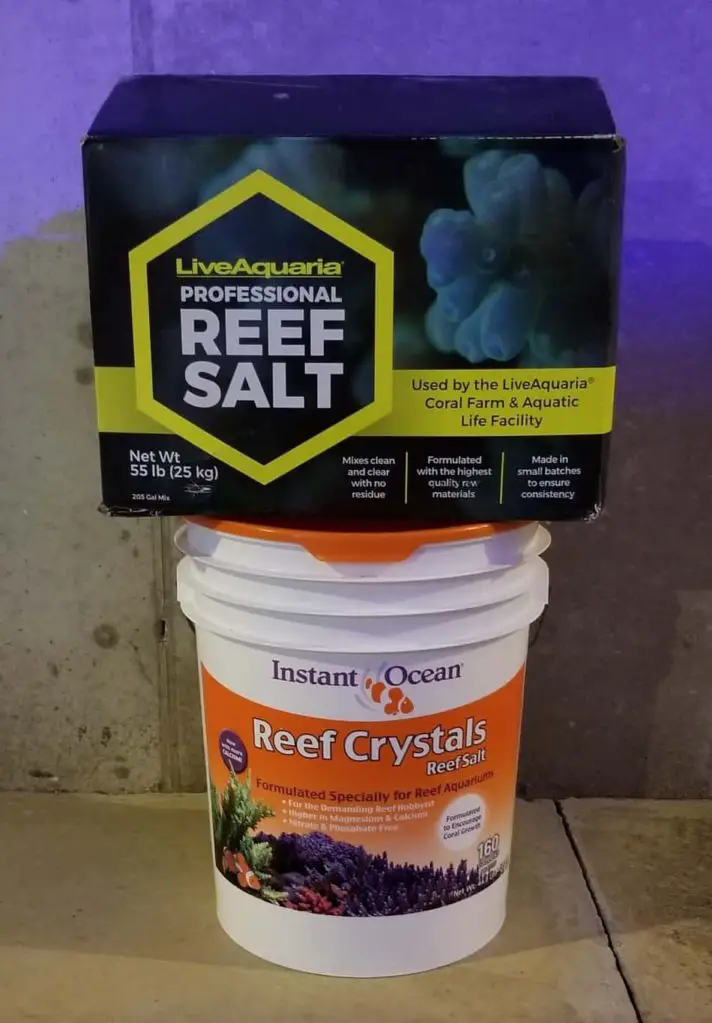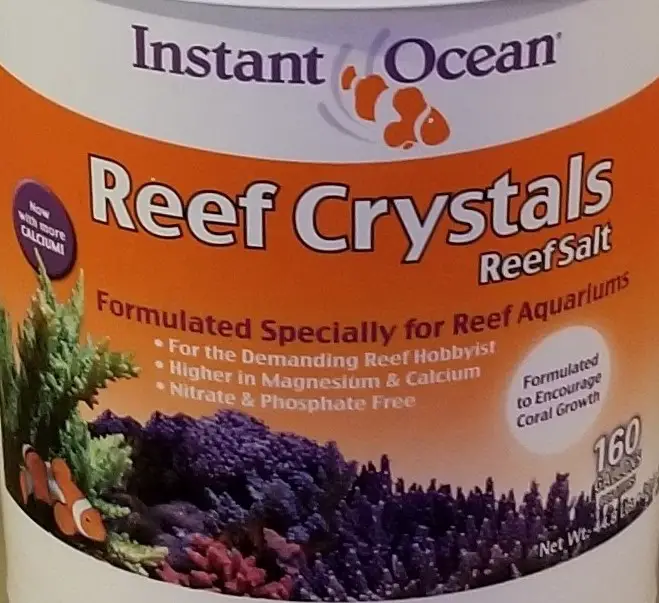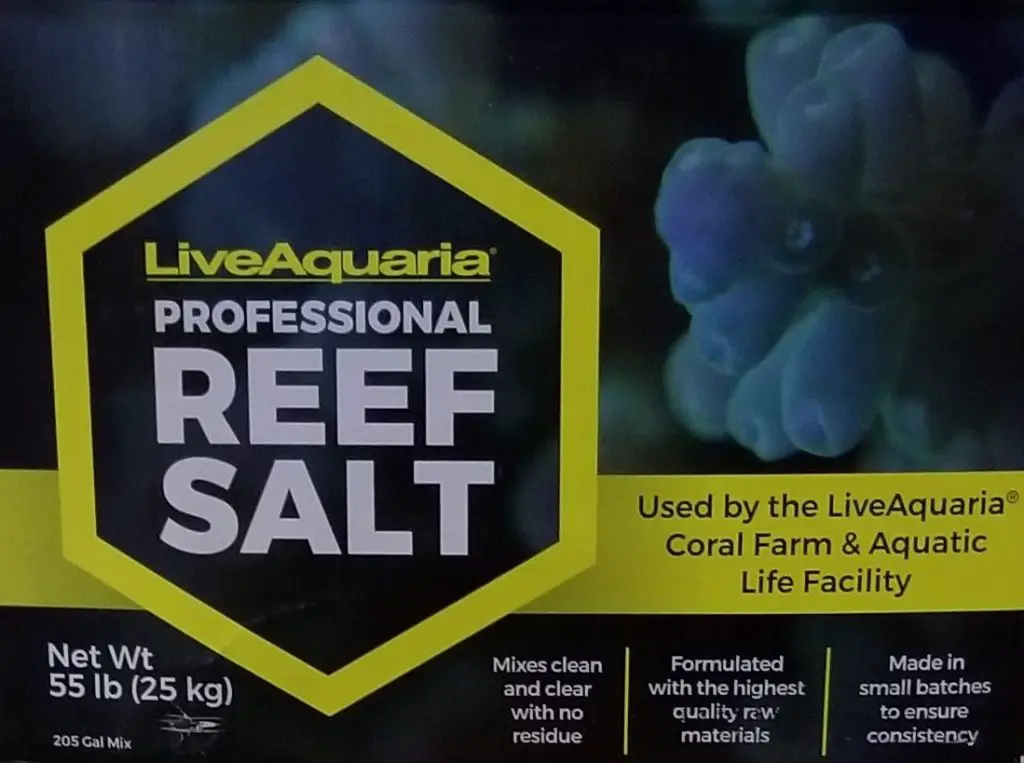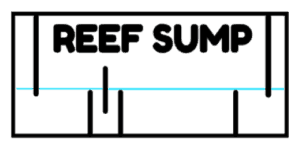
Like many beginner reefers, my first salt mix was the good old purple box, Instant Ocean Reef Salt. When I started in the hobby there weren’t many options and I was on a very strict budget, enter Instant Ocean Reef Salt. Instant Ocean Reef Salt was used by many reefers that I saw on the internet, that I know, and was even recommended by the local fish store that I use to visit back in the day. The best thing about this salt is that it is very budget-friendly and among the lowest price per gallon on the market currently and at the time. This salt served me well for many years on my 55 Gallon ReefSumper Origin Tank. In this tank, I mainly had fish with some hardy corals and anemones. Eventually, my reef keeping skill level improved and I would build out my second tank a 75 Gallon Marineland Mixed Reef Tank. Armed with improved reef keeping knowledge I knew that there were better options than the budget Instant Ocean Reef Salt I used for years. With the 75 gallon tank, I wasn’t quite ready to venture into SPS coral and wanted to start with beginner LPS and soft coral. Based on my needs I would end up switching to Instant Ocean’s Reef Crystals when I upgraded tanks to my 75 Gallon Marineland Mixed Reef Tank.
I would use Instant Ocean Reef Crystals for many years on my 75-gallon mixed reef tank and continue even on my newest 210 Gallon Aqueon Big Fish Mixed Reef Tank. I found Reef Crystals to be on the lower price range of comparable salts and performed very consistent over time. I never experienced any issues with Reef Crystals.
My typical process is to brew a batch of saltwater the night before in a container with a heater and powerhead. By the next day, the water would be ready for the water change and was consistently in the proper salinity range with very little adjustments needing to be made. I have seen some reports and reviews online that describe scum being built up over time in mixing buckets that are not rinsed regularly. I never experienced this as I rinse and dry my mixing containers after each water change. Overall I would recommend Reef Crystals for fish and LPS/soft coral systems without hesitation. With that said there were a few compelling reasons that ultimately lead me to change salts.
Instant Ocean Reef Crystals Overview

Instant Ocean Reef Crystals Reef Salt
Enriched formulation. Optimum effectiveness. Formulated specially for use in reef aquariums, Reef Crystals contains essential ocean reef elements in concentrations greater than those found in natural sea water.
Instant Ocean Reef Crystals come in various sizes: a 10-gallon mix, 25-gallon mix, 50-gallon mix, a 160-gallon bucket, and a 200-gallon box. Instant Ocean advertises that Reef Crystals contain greater amounts of essential elements than in natural seawater including extra calcium and other trace elements. The company also reports that its salt neutralizes heavy metals found in tap water. Instant Ocean recommends using a ½ cup of salt per gallon of water when mixing.
LiveAquaria Professional Reef Salt Overview

LiveAquaria Professional Reef Salt is a relatively new product and hit the market in 2017. LiveAquaria Professional Reef Salt is currently offered in three sizes: a 53-gallon mix bag (14lbs), a 180 Gallon bucket (48lbs), and a 205-gallon box (55lbs). The 205-gallon mix usually offers the best price per gallon. The company markets its synthetic salt as a good product for all marine aquariums including tanks supporting coral life. Two other advantages the company claims are that there is no leftover residue and the salt mixes very quickly compared to other salts on the market. A half-cup of salt per gallon of water is recommended for mixing. From their website, the company advertises that its salt mix contains the same elements as natural seawater and has the following parameters:
- Salinity: 35 ppt (1.026 sg)
- Calcium: 400-450 ppm
- Magnesium: 1,350-1,450 ppm
- Alkalinity: 8.0-9.5 dKH
- Strontium: 9 ppm
- Potassium: 400 ppm
The company recommends the usual process for mixing saltwater: the use of RO/DI water, something to mix the water like a pump or powerhead, and heating the water to 70-78 degrees. LiveAquaria also recommends allowing 2-4 hours of mixing to stabilize PH and completely dissolve all of the salt. LiveAquaria is a national company that moves a lot of fish and coral in the United States online and through Petco. The scale of their system is massive and the company uses its brand of salt to support its systems. If they’re confident using their product at the risk to their operations, it is a big selling point for consumers to trust the salt is safe for their own systems.
Why I Switched from Reef Crystals to LiveAquaria Professional Reef Salt
As I outlined in the introduction, I used Reef Crystals for several years, trusted the product, overall had great results with the salt, and would recommend the product to others. So what was the main driver for me making the switch? As a long-time budget reefer, it simply came down to the ability to get large quantities of LiveAquaria Professional Reef Salt at a large discount compared to Reef Crystals. Another factor for me was the fact that LiveAquaria uses salt in its retail livestock system. To use your salt on such a large retail operation convinced me that the product was safe to use in my own system. On the surface, the marketing of the product and its components made it sound like an upgrade to Reef Crystals if not at least an equivalent.
How to Get Discounted LiveAquaria Professional Reef Salt
When I buy salt I buy the biggest box of salt available. Buying the big box decreases the frequency of having to buy salt and is usually the best price on a per-gallon basis. For Reef Crystals I would often find the best price for their big box on Amazon or at my local fish store. LiveAquaria professional reef salt is usually only found at LiveAquaria’s website and through Petco. If you go to LiveAquaria for their salt you will find that the typical price of the salt is about the same as Reef Crystals. At the time of this writing, LiveAquaria is owned by Petco. To get the best price I usually will go to Petco’s website to purchase the salt and have it delivered directly to my home. When the salt is being sold through Petco’s website it will often go on sale, be eligible for different promotions, and often even ships free depending on meeting minimum spend requirements or other shipping promotions. Additionally, you can often find discounted Petco gift cards online through various gift card resalers. When I buy salt I try to hit a good promotion and buy multiple boxes at a discounted price. Here are the things I look at for getting a good deal:
- Wait for the salt to go on sale and for a good promotion like $30 off $100
- Get free shipping based on minimum spend which is usually $49
- Find a discount gift card online which can usually be in the 5-20% off range
Here is an example of the last deal I was able to secure. Remember these deals come and go and you have to be aware of when they change.
- Petco.com had the big salt boxes on sale for $48.19
- Free shipping was included for spending more than $49
- Petco.com offered a promo code for $30 off spending $100 or more
- I secured an instant Petco egift card on Raise.com for 11% off its face value. I spent $89 for a $100 gift card.
I ordered 3 boxes of salt shipped free for the following:
- 3 boxes at $48.19 = $144.57
- $144.57 – $30 off promo = $114.57
- $114.57 – $100 gift card = $14.57
- $89 cost of gift card + $14.57 after gift card = $103.57 total cost
This comes out to $34.52 per 205-gallon box of salt or about $0.06 a gallon of mixed saltwater. This was a heck of a deal that happens pretty regularly and made it an easy decision for me to switch.
Making the Change to LiveAquaria Professional Reef Salt
I consider the brand and type of salt being used as the main component in reef keeping and was very hesitant to make a drastic change by moving to a new salt brand. One of my beliefs on successful reef keeping is that stability is king in keeping a healthy and thriving reef tank. The potential to change the chemistry of your system is very high when switching salts and I did not want to cause a catastrophic failure by switching salts brands.
To prepare for the change, I made sure to test all the parameters of my tank each week for three weeks while using my remaining Reef Crystals. I checked calcium, ph, nitrate, nitrite, ammonia, and phosphate. I tested rigorously to make sure I had a good baseline. In the meantime, I used up the rest of my Reef Crystals and prepared to conduct the first water change using the LiveAquaria salt.
For the first water change, I did about half the normal amount of water change on my 210 Gallon Aqueon Big Fish Mixed Reef Tank. I made sure the water was well mixed and aerated by mixing it overnight and triple-checking salinity. After completing the water change I checked on my aquarium inhabitants throughout the rest of the day to see if they were displaying any effects of the new salt. I was particularly looking at stress levels of the fish including differences in breathing and if the corals were receding at all. Overall I didn’t notice any differences in the tank mates after the initial water change.
I continued conducting my normal water changes weekly on my 210-gallon tank. On the second-week water change, I ratcheted up to 2/3 the normal water change and did a regular amount water change the third week and moving forward. For each water change, I would observe the tank and test my parameters regularly. Each week I saw a very limited impact on the display tank and parameters.
Differences Between LiveAquaria Professional Reef Salt and Instant Ocean Reef Crystals
After fully transitioning to LiveAquaria Professional Reef Salt I would say at face value I didn’t notice much of a difference inside the tank. My fish and corals were happy with Reef Crystals and continued to be happy and healthy with LiveAquaria salt. I had established coralline algae in the tank and it continued to thrive after the transition. Testing was about the same with slightly higher concentrations of the good elements with the LiveAquaria salt.
There were some good things that I did like about the salt. I seemed to be getting higher salinity by using less salt. I would typically use 10 cups of reef crystals to mix up 20 gallons of saltwater. I found with the LiveAquaria salt I would only need 9 cups to get the same salinity. Not sure why there was that difference, but it could lead to less salt used over time. I also found that as advertised, the LiveAquaria salt did mix up faster than Reef Crystals. Most of the time I was waiting for the water to get up to temperature rather than waiting on the salt to dissolve.
Overall I assess that performance-wise LiveAquaria salt is about the same but slightly superior when it comes to the time to dissolve and mix. The real benefit of LiveAquaria salt is the ability to acquire it at a much lower price point than Reef Crystals. This is a point that could change in the future, but it was such a large advantage to my reef-keeping strategies that I switched over.
LiveAquaria Professional Reef Salt Drawbacks
After using LiveAquaria professional Reef Salt for a while now, I can confidently recommend the product. Overall I found it to perform on par with some advantages as listed above. I do have some minor complaints but am more on the nitpicky side of things. First, I dislike the box itself. The box has color pictures and lettering that are a bit glossy and heavily inked. The box is also very heavy. The high amount of glossy ink and the weight of the box causes the ink to smear on your hands and clothing when carried. It washes off fine but requires clothes to go through the wash if it smears on them.
My other gripe is with the plastic salt package inside the box. The salt comes in a single plastic bag within the box. Once opened, there isn’t a good way to reseal the bag tightly. This can be a problem if the salt gets exposed to water or humidity. Reef Crystals come packaged in multiple smaller bags within the box. When I would get a new box of Reef Crystals I would transfer the salt into an airtight bucket with ease. This is a little harder with the LiveAquaria salt boxes as it is a single heavy 55-pound bag. I made a bit of a mess the first time I transferred the salt over to my salt bucket. The bag is secured by a zip tie that can be reopened after closing, but I prefer keeping my salt in a bucket. Another unintended drawback is the extra work I give the mailman. In the past, I usually would order a single box of Reef Crystals with the LiveAquaria salt I often order 3-6 boxes at 55 lbs. apiece. I presume that the mailman isn’t too thrilled to make these deliveries to my home. Again these are minor things that I’ve been able to work around and with the price to value ratio it is worth the effort to me.
Instant Ocean Reef Crystals Reef Salt
Enriched formulation. Optimum effectiveness. Formulated specially for use in reef aquariums, Reef Crystals contains essential ocean reef elements in concentrations greater than those found in natural sea water.

